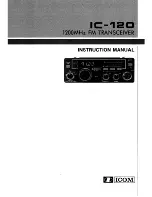
43
Maintenance
•
Do not knot the cables or use clips to mark a certain depth.
•
Do not place the instrument where the cable might be severed or damaged by boat
propellers or other moving parts.
•
Protect all cables from abrasion, unnecessary tension, repetitive flexure, or bending
over sharp radii (e.g., the side of a boat or of a bridge). Do not bend or run the cable
over the sheave or pulleys with less than a 6-inch diameter.
•
If cables are long, use a battery-powered or hand-cranked reel with electrical
slip-rings to lower and raise the instrument. Also, a lighter reel without slip-rings for
shorter cables can be used. A last option, is to mount the reel horizontally with the
instrument and battery installed in the hub.
•
Use the V-shaped support bail to lift and lower the multiprobe.
•
Do not apply more than 5 kilograms (10 lb) of sinking weight to the multiprobe. This
can increase the possibility of cable breakage due to stress on the attachment points.
If more weight is needed, use a wire line to support the instrument by its bail.
6.4 Sensor Maintenance
Important Note:
If a sensor is not in use, insert an optional sensor expansion port plug in
the vacant expansion port to prevent any contamination or damage during maintenance,
operation, or storage.
6.5 Clark Cell Dissolved Oxygen Maintenance
Dissolved oxygen sensor maintenance is required when the membrane covering the cell
becomes wrinkled, bubbled, torn, dirty, fouled, or otherwise damaged.
1.
Remove the O-ring securing
the D.O. membrane.
Remove the old membrane.
Shake out the old electrolyte
and rinse with fresh D.O.
electrolyte.
2.
Refill with fresh D.O.
electrolyte until there is
a perceptible meniscus
of electrolyte rising
above the entire
electrode surface of
the sensor.
3.
Make sure there are no
bubbles in the
electrolyte.
4.
Hold one end of a new
membrane against the
body of the D.O. sensor
with your thumb and with
a smooth, firm motion,
stretch the other end of
the membrane over the
sensor surface and hold
it in place with your index
finger.
Summary of Contents for Hydrolab DS5
Page 2: ......
Page 8: ......
Page 14: ......
Page 17: ...17 Installation Figure 5 Assembly Options...
Page 18: ......
Page 34: ...34 Deployment Figure 12 Open Water Deployment...
Page 52: ......
Page 68: ......
















































